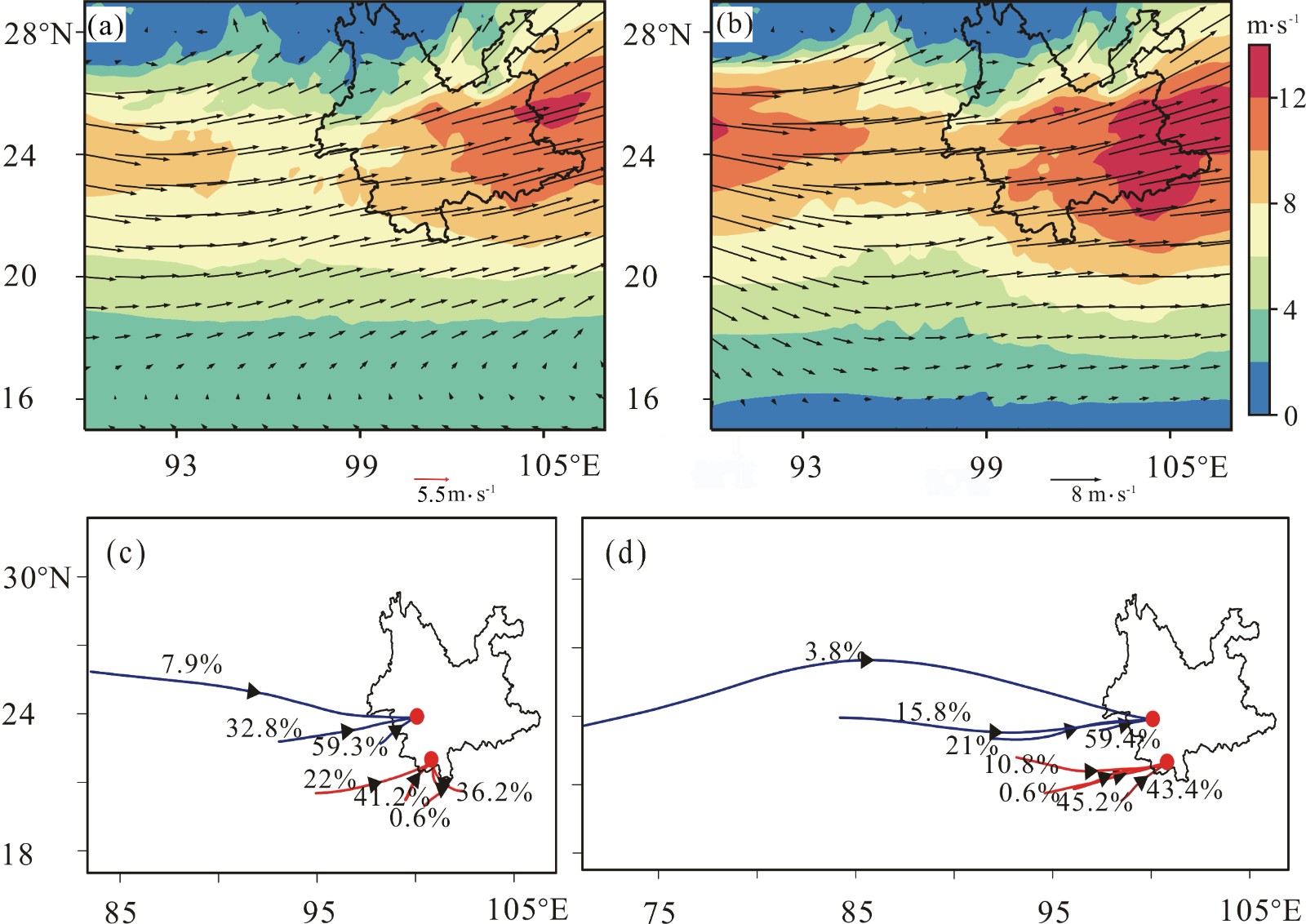本文已被:浏览 359次 下载 2258次
投稿时间:2022-01-19 修订日期:2022-08-18
投稿时间:2022-01-19 修订日期:2022-08-18
中文摘要: 利用CHAP PM2.5、MODIS MCD19A2、ERA5再分析等数据集,以及SNPP/VIIRS卫星监测火点等数据,从污染物后向轨迹、环流形势、高低空动力结构配置等方面入手,采用最小二乘法等多种分析方法对滇西南地区年均和四季PM2.5浓度时空分布及季节性突增的成因进行探究。结果表明:研究区PM2.5浓度和气溶胶光学厚度空间分布均呈北低南高,东弱西强;PM2.5浓度年内7月最低、3月最高。2—4月稳定的污染源输送造成研究区春季PM2.5浓度值高且波动较其余季节小,但变化百分率空间分布差异更明显;近20年PM2.5浓度变化百分率减少程度以-30%~-20%居多,夏、秋、冬季变化百分率则以小于-30%为主。研究区紧邻的缅甸东部和老挝北部一年中超过90%的火点发生在2—4月,在偏西气流引导下,途经高火点区的偏西向(西南向)污染物短距离输送,在上空中低层辐散的动力作用下造成下沉,致使研究区PM2.5浓度季节性升高。较大范围利于污染物扩散的气象条件和更多降水的清洗,可减少境外大气污染物输送对滇西南地区PM2.5污染的贡献。关键区境外火点数变化对PM2.5浓度及气溶胶光学厚度的影响表现为显著正相关,且其对PM2.5的影响滞后于火点数变化2天左右,二者相关程度由南向北逐渐减弱。
中文关键词: PM2.5时空变化,气象因素,火点,相关性,滇西南地区
Abstract:Using the data of CHAP PM2.5 and MODIS MCD19A2, the ERA5 reanalysis data and the SNPP/VIIRS satellite monitoring fire point data as well as the least squares method and other analytical methods, this paper explores the spatio-temporal distribution pattern of PM2.5 concentrations in southwest Yunnan and the causes of seasonal bursts from the aspect of backward trajectory of pollutants, circulation situation, high and low air dynamic structure configuration, etc.. The results show that the spatial distribution of PM2.5 concentration and aerosol optical depth (AOD) in the study area are in the pattern of high values in the south and west but low values in the north and east. The PM2.5 concentration is the lowest in July but is the highest in March in a year. The stable transport of pollution sources from February to April causes the spring PM2.5 concentration value in the study area to be higher and the fluctuation to be smaller than in the other three seasons. However, the spatial distribution of the percentage change is more obvious. The percentage reduction in PM2.5 concentration in the past 20 years was mostly by from -30% to -20%, and the percentage change in summer, autumn and winter was mainly less than -30%. More than 90% of the fire points in eastern Myanmar and northern Laos, which are adjacent to the study area, occur from February to April. Under the guidance of the westerly air flow, the westward (southwest-oriented) pollutants are transported over a short distance through the high-fire point area, causing subsidence under the dynamic action of low-layer radiation dispersion in the upper air, and resulting in a seasonal increase in PM2.5 concentration in the study area. A large range of meteorological conditions conducive to the spread of pollutants and the cleaning of more precipitation can reduce the contribution of overseas air pollutants to PM2.5 pollution in southwest Yunnan. The effects of changes in fire points outside the key areas on PM2.5 concentration and AOD show a significant positive correlation. Their effects on PM2.5 lagged behind the change in fire points by about 2 days, and the correlation between the two gradually weakens from south to north.
keywords: spatio-temporal variation of PM2.5, meteorological factor, fire point, correlation, southwest Yunnan
文章编号: 中图分类号: 文献标志码:
基金项目:国家可持续发展创新议程示范区专项(202104AC100001-A14)、国家自然科学基金项目(21966016)和国家重点研发计划(2019YFC0214405)共同资助
| 作者 | 单位 |
| 赵平伟 | 云南省临沧市气象局,临沧 677099 |
| 杨力羽 | 昆明市生态环境科学研究院,昆明 650032 |
| 李斌 | 云南省临沧市气象局,临沧 677099 |
| 尤文龙 | 云南省临沧市气象局,临沧 677099 |
| 王佳妮 | 云南省临沧市气象局,临沧 677099 |
| 史建武 | 昆明理工大学环境与工程学院,昆明 650500 |
| 韦晶 | 马里兰大学大气与海洋科学系地球系统科学跨学科研究中心,马里兰州 20740 美国 |
引用文本:
赵平伟,杨力羽,李斌,尤文龙,王佳妮,史建武,韦晶,2023.滇西南地区PM2.5时空变化特征及其季节性增强的成因分析[J].气象,49(1):87-98.
ZHAO Pingwei,YANG Liyu,LI Bin,YOU Wenlong,WANG Jiani,SHI Jianwu,WEI Jing,2023.Spatio-Temporal Variation of PM2.5 and Its Causes of Seasonal Enhancement in Southwest Yunnan[J].Meteor Mon,49(1):87-98.
赵平伟,杨力羽,李斌,尤文龙,王佳妮,史建武,韦晶,2023.滇西南地区PM2.5时空变化特征及其季节性增强的成因分析[J].气象,49(1):87-98.
ZHAO Pingwei,YANG Liyu,LI Bin,YOU Wenlong,WANG Jiani,SHI Jianwu,WEI Jing,2023.Spatio-Temporal Variation of PM2.5 and Its Causes of Seasonal Enhancement in Southwest Yunnan[J].Meteor Mon,49(1):87-98.


